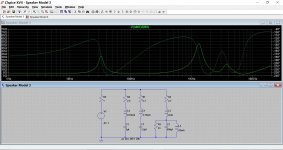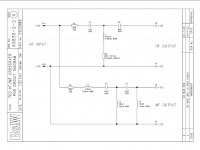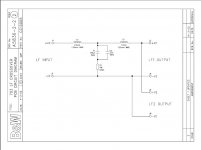Have you heard the amp? Do you believe in the spscs?
No, I have not heard one.
Yes I do feel the specs are honestly stated. I have no reason not to believe the specs, as Benchmark is very reputable in the professional audio industry.
If the specs are accurate, do you think any crossover distortion would be audible?
It's not clear if the results would have been different if people all used the same reproduction system, or different reproduction systems than they did. That is, it's not clear we can separate out the listening environment from amplifier model preferences, and talk about preferences in isolation.
That's true. We are making an assumption that taking the speaker feed of an amp and listening (usually for these tests) via headphones will give a decent representation of the amp.
Hats off. This is really a useful and innovative idea to test an amp. Im sure it has validity as long as we understand and take into account the assumptions used in the modelling (and having good ears of course). This is also equally true with analyzing amp performance using simulation only.
Two issues are the effect of environmental interference or power supply and the effect of parts mismatch in the real build (some circuit can be very sensitive).
BTW, my listening preference was for amp1. I thought this is the fet amp and amp3 was jlh. This guess is mainly based on the superior fft of the fet amp which seems to me to be too good to be true.
Simulation doesnt have to be exact representation of reality, but it must show good correlations and differences. The FFT for example, from your sim it is obvious that amp3 has no drawbacks at all when compared to amp1. I dont think this is true in real life. So the simulator should model this differences. In my experience, theres no class b amp that can match class a amp in certain area of quality. I can see this differences in simulation where class a amps always have clean vhf distortion. The jlh for example, with my simulation setup, at 20khz the response is -210dB! This is unachievable with any class b amps i have simulated, not even from current feedback amps.
Your class b amp, once the right setup is used, i believe will show what i have usually seen in class b amps FFTs, which represents my dislike over the jlh. The fet amp to my ears was very slightly less fatiguing than jlh. This is strange. I believe this is because the system relies on the theoretical perfect matching of the model and negates the effects of HF combined with power supply.
Thanks
Matching of models is a good point. The FET amp with its single ended input stage (and the JLH) aren't so influenced by this. The Europa has a totally odd ball input stage and so that doesn't matter here either. However take an amp with a true balanced differential input stage and the model matching is of course perfect, something we could never achieve in practice.
I have no reason not to believe the specs, as Benchmark is very reputable in the professional audio industry.
I mean, do you believe the good thd+noise correlates to our preference? We need thd only until a level we can no longer perceive. Probably 0.001%. Same with noise. But where are the other 'measurement's that we need? The third critical one is voice coil control, currently represented by damping factor, but is not the right metrics imho.
If the specs are accurate, do you think any crossover distortion would be audible?
Even in regular amps im not sure about crossover distortion audibility. Its like blind testing a class A amplifier with a class B amplifier, I am not sure if it is easy or not to perceive.
...The third critical one is voice coil control, currently represented by damping factor, but is not the right metrics imho.
Maybe so, but what else can you do without getting into speaker design? We seem to be talking about isolated amplifiers here.
That's true. We are making an assumption that taking the speaker feed of an amp and listening (usually for these tests) via headphones will give a decent representation of the amp.
Okay. It's just that I made a similar assumption with the recent tambourine test, and it turned out that some laptops have abysmally poor audio, maybe -70 dB THN+N. Maybe not no easy to hear subtleties with that. Also, with your amp simulation test here, I had to listen on the NS-10s to hear the differences. I tried some pretty good Sennheiser headphones straight out of the DAC-1 headphone amp, and couldn't hear the differences nearly as well. So, at this point, its looking more and more to me like the assumption you mention, unfortunately and inconveniently, may not in all ways be a good assumption. Wish it were otherwise, of course. Don't know what to can be done about it.
But, honestly, I think if most of the people here who participated in listening could have been listening along at the same time I did, there would be much less variation in voting and opinions. So, the fact that the distribution of votes and other written descriptions in posts came out the way they did, I don't think is so much a matter of model preference alone, as much it is an artifact of the listening systems people used.
Maybe so, but what else can you do without getting into speaker design? We seem to be talking about isolated amplifiers here.
No need to get into speaker design. Just knowing something from someone who does. Active XO is good because the amp has direct control over voice coil. With passive XO the amp must work 'harder'. The "harder' the XO the more we need from amp. I use second order XO as typical load for an amp. But this is not too critical. Amplifier ability to control speaker, or damping, is a function of current. I'm not going to be specific but observe what happen when you increase gain. You lost in thd but gain in what. Then you just need to set a threshold after correlating these numbers with perception.
If the feedback in your amp is determined by 10k over 100 Ohm resistors, try changing the 100R with 82R or 120R and listen. Which one do you prefer? This is to understand that there is trade off taking place. Then find out in spice what really changed when you change the gain.
No need to get into speaker design. Just knowing something from someone who does. Active XO is good because the amp has direct control over voice coil.
Sure, understood. But my speakers have built-in crossovers. If I wanted to switch to active crossovers, I would basically be changing the speaker design. So, in that sense, I think we would be getting into speaker design, and I think the sound of my speakers would change as a result.
But no disagreement that one amplifier per driver, preferably located nearby to the driver, is probably ideal for best performance. Then the amplifier can be tuned, or optimized, to work best with each particular driver.
That being said, the amplifiers we have been comparing so far in this thread are general-purpose amps, designed to work with almost any normal type of speaker. For general-purpose power amplifiers, I still don't see how specification of damping factor at various frequencies would be lacking in some way. That is, I don't see what else general-purpose power amp designers can do or should do beyond that. Again, special-purpose amplifiers designed to work with particular individual drivers would a different subject.
I don't think is so much a matter of model preference alone, as much it is an artifact of the listening systems people used.
I dont think the individual system matters that much (in skewing the result). There are situations where it does. For example, when one of the DUT is 'special' in bass response, usually very low in frequency, a wideband speaker (I have never heard headphone that is capable) will increase the chance of the DUT to be recognized.
Otoh, if you focus on listening to distortion, good speaker and amps will only make it harder to hear any differences. Different systems may change audibility level but hardly the result. If there is 'listening system artifact', this artifact is experienced by all DUT most of the time.
Otoh, if you focus on listening to distortion, good speaker and amps will only make it harder to hear any differences.
I guess it would depend on what you mean by "good speaker and amps." To me, "good speaker and amps" means they are very good at revealing any distortion or other problems (including bass problems) in the source files being listened to.
If my speakers hid those things instead of revealing them, I would not consider my speakers, amp, and/or DAC to be good. There would have to be something wrong with at least one of those components.
That is, I don't see what else general-purpose power amp designers can do or should do beyond that. Again, special-purpose amplifiers designed to work with particular individual drivers would a different subject.
Oh yes, there are a lot of things to be done. Those who believe that this is a 'matured' area of engineering are wrong. Why do you think is the reason of eternal debates in many topics in audio??
Special amp for a particular drivers is a joke. Unless it means poor amp for non critical load and requirements.
Hai Mooly...
What you're doing is a great job...
You have been helping so much...
I will test it tonight(my local time West Indonesia Area)...
Cause i have so much problem with the last thing sit on my table...
Thanks boss
You are great...
I will pull my words ---> I AM GIVE UP...
It's my fault
Once again thank you Man...
What you're doing is a great job...
You have been helping so much...
I will test it tonight(my local time West Indonesia Area)...
Cause i have so much problem with the last thing sit on my table...
Thanks boss
You are great...
I will pull my words ---> I AM GIVE UP...
It's my fault
Once again thank you Man...
If my speakers hid those things instead of revealing them, I would not consider my speakers, amp, and/or DAC to be good.
I was talking about distortion, especially THD. Distortion is harder to perceive than frequency response variation or SPL. Distortion causes fatigue. Fatigues caused by DUT, amp and speaker will be summed at the ears. When the level of the fatigue is too low, it cannot be perceived. A perfect amp and speaker is like a perfect/easy load for DUT. You will hardly hear differences.
It will be very intersting if you can confirm over time that the virtual audition correlates closely to the perceptions and preferences of the listener to the real thing, at least relative to the other amps in the test
You could also do a tube amp version with SET vs PP vs exotic tubes etc?
And mosfet vs class d vs chip amp...
Good fun
You could also do a tube amp version with SET vs PP vs exotic tubes etc?
And mosfet vs class d vs chip amp...
Good fun
This has been tossed around a lot in other topics, but speaker cables can act like transmission lines at higher audio frequencies. Even cables a short as 6 feet long exhibit transmission line behavior. And getting around that issue at audio frequencies is very difficult. Typical transmission line equations are not accurate at audio frequencies is a related problem, since the equations are simplifications of Maxwell's equations using assumptions good only at RF frequencies.
Anyway, it means there are phase shifts at high frequencies that aren't accounted for by lumped models of crossovers and speakers.
Our old friend jneutron is the expert on this.
Anyway, it means there are phase shifts at high frequencies that aren't accounted for by lumped models of crossovers and speakers.
Our old friend jneutron is the expert on this.
Last edited:
Thanks 
I was trying to make a load that was something like my B&W 703's. I know they are reputed to be a little difficult but I couldn't find a proper plot anywhere.
B&W 703, HTM7, 705, ASW750 surround speaker system Measurements | Sound & Vision
It uses two bass drivers in parallel.
I was trying to make a load that was something like my B&W 703's. I know they are reputed to be a little difficult but I couldn't find a proper plot anywhere.
B&W 703, HTM7, 705, ASW750 surround speaker system Measurements | Sound & Vision
The B&W 703's ported enclosure is tuned to approximately 32Hz, and its minimum impedance is 2.8ohms at 100Hz. The impedance remains below 4ohms from about 79Hz to 400Hz—a region of the frequency spectrum that is dense with fundamentals and requires more of an amplifier, over time, than even the deep bass (which makes huge but less constant demands). I would judge this speaker to be moderately difficult to drive. For that reason, I would conservatively rate its nominal impedance at 4ohms. The 703's sensitivity measured about 88dB/2.83V/m.
Read more at B&W 703, HTM7, 705, ASW750 surround speaker system Measurements | Sound & Vision
It uses two bass drivers in parallel.
Attachments
- Status
- This old topic is closed. If you want to reopen this topic, contact a moderator using the "Report Post" button.
- Home
- Member Areas
- The Lounge
- Welcome to the (virtual) listening room.



